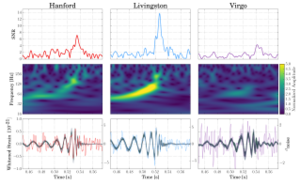User:Eric Genin/sandbox
The instrument[edit]

Seen from the air, the Virgo detector has a characteristic "L" shape with its two 3-km long perpendicular arms. The arm "tunnels" house vacuum pipes with a 120 cm diameter in which the laser beams are travelling under ultra-high vacuum. To increase the interaction between the light and an incoming gravitational wave, a Fabry-Perot optical cavity is installed in each arm as well as a mirror called "recycling mirror" at the instrument entrance, between the laser source and the beam splitter.
Virgo is sensitive to gravitational waves in a wide frequency range, from 10 Hz to 10,000 Hz.
Laser and Injection system[edit]
- The laser is the light source of the experiment. It must be powerful, while extremely stable in frequency as well as in amplitude.[1] To meet all these specifications which are somewhat opposing, the beam starts from a very low power, yet very stable, laser.[2] The light from this laser passes through several amplifiers which enhance its power by a factor 100. A 50 W output power was achieved for the last configuration of the initial Virgo detector—called "Virgo+"—while in the final configuration of Advanced Virgo, the laser will deliver 200 W.[3] The retained solution is to have a fully fibered laser with an amplification stage made of fibers as well, to improve the robustness of the system. That laser is actively stabilised in amplitude, frequency and position, in order to not inject additional noise in the interferometer, and hence to improve the sensitivity to the gravitational wave signal.
The initial Virgo detector[edit]
The initial Virgo detector recorded scientific data from 2007 to 2011 during four science runs.[4] Several upgrades happened druing this phase. The first one was called Virgo+. It was a major upgrade for what concerns the Laser and Injection system since the laser output power was increased from 20 to 50W. The injection system (IMC cavity and many components of the Injection system benches) was upgraded to be able to work with higher power.
The laser[edit]
The Advanced Virgo detector[edit]

The Advanced Virgo aims to be 10 times more sensitive than the initial Virgo.[5] According to the Advanced Virgo Technical Design Report VIR–0128A–12 of 2012, advanced Virgo keeps the same vacuum infrastructure as Virgo, with four additional cryotraps located at both ends of both three-kilometre-long arms to trap residual particles coming from the mirror towers, but the remainder of the interferometer has been significantly upgraded. The new mirrors are larger (350 mm in diameter, with a weight of 40 kg), and their optical performances have been improved.[3] The critical optical elements used to control the interferometer are under vacuum on suspended benches. A system of adaptive optics was to be installed to correct the mirror aberrations in-situ.[3] In the final Advanced Virgo configuration, the laser power will be 200 W.
A milestone for the Advanced Virgo was reached in 2017 with the installation of the new detector. A first joint science run with LIGO, in the second half of 2017, started following a commissioning period of a few months.
The first detection of gravitational waves by Virgo is known as GW170814, which was announced on 27 September 2017 in a G7 science meeting conference in Turin, Italy.[6][7]
Just few days later, GW170817 was detected by the LIGO and Virgo on 17 August 2017. The GW was produced by the last minutes of two neutron stars spiralling closer to each other and finally merging, and is the first GW observation which has been confirmed by non-gravitational means.
The full design sensitivity of the Advanced Virgo should be achieved in 2019.
- ^ F. Bondu; et al. (1996). "Ultrahigh-spectral-purity laser for the VIRGO experiment". Optics Letters. 21 (8): 582–4. Bibcode:1996OptL...21..582B. doi:10.1364/OL.21.000582. PMID 19876090.
- ^ F. Bondu; et al. (2002). "The VIRGO injection system" (PDF). Classical and Quantum Gravity. 19 (7): 1829–1833. Bibcode:2002CQGra..19.1829B. doi:10.1088/0264-9381/19/7/381.
- ^ a b c Many authors of the Virgo Collaboration (13 April 2012). Advanced Virgo Technical Design Report VIR–0128A–12 (PDF).
- ^ Accadia, T.; Acernese, F.; Alshourbagy, M.; Amico, P.; Antonucci, F.; Aoudia, S.; Arnaud, N.; Arnault, C.; Arun, K. G.; Astone, P.; Avino, S.; Babusci, D.; Ballardin, G.; Barone, F.; Barrand, G.; Barsotti, L.; Barsuglia, M.; Basti, A.; Bauer, Th S.; Beauville, F.; Bebronne, M.; Bejger, M.; Beker, M. G.; Bellachia, F.; Belletoile, A.; Beney, J. L.; Bernardini, M.; Bigotta, S.; Bilhaut, R.; Birindelli, S. (2012-03-29). "Virgo: a laser interferometer to detect gravitational waves - IOPscience". Journal of Instrumentation. 7 (3): P03012. Bibcode:2012JInst...7.3012A. doi:10.1088/1748-0221/7/03/P03012.
{{cite journal}}: Unknown parameter|displayauthors=ignored (|display-authors=suggested) (help) - ^ Acernese, F.; Agathos, M.; Agatsuma, K.; Aisa, D.; Allemandou, N.; Allocca, A.; Amarni, J.; Astone, P.; Balestri, G.; Ballardin, G.; Barone, F.; Baronick, J-P; Barsuglia, M.; Basti, A.; Basti, F.; Bauer, Th S.; Bavigadda, V.; Bejger, M.; Beker, M. G.; Belczynski, C.; Bersanetti, D.; Bertolini, A.; Bitossi, M.; Bizouard, M. A.; Bloemen, S.; Blom, M.; Boer, M.; Bogaert, G.; Bondi, D.; Bondu, F. (2015). "Advanced Virgo: a second-generation interferometric gravitational wave detector - IOPscience". Classical and Quantum Gravity. 32 (2): 024001. arXiv:1408.3978. Bibcode:2015CQGra..32b4001A. doi:10.1088/0264-9381/32/2/024001.
{{cite journal}}: Unknown parameter|displayauthors=ignored (|display-authors=suggested) (help) - ^ "European detector spots its first gravitational wave". 27 September 2017. Retrieved 27 September 2017.
- ^ Cite error: The named reference
paperwas invoked but never defined (see the help page).

